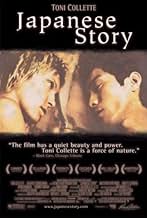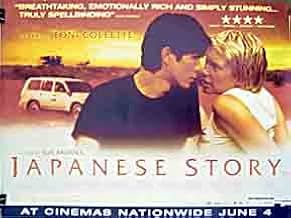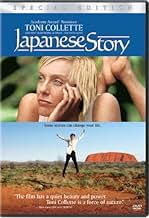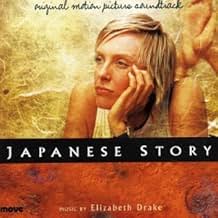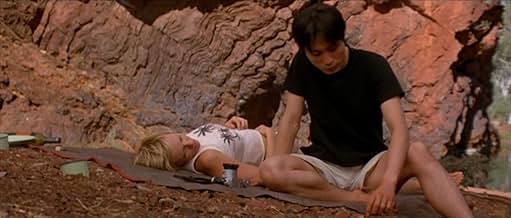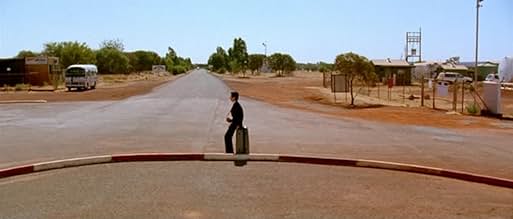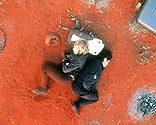Adicionar um enredo no seu idiomaAgainst the background of an Australian desert, Sandy, a geologist, and Hiromitsu, a Japanese businessman, play out a story of human inconsequence in the face of the blistering universe. The... Ler tudoAgainst the background of an Australian desert, Sandy, a geologist, and Hiromitsu, a Japanese businessman, play out a story of human inconsequence in the face of the blistering universe. The end of the journey leaves no one capable of going back to where they started from.Against the background of an Australian desert, Sandy, a geologist, and Hiromitsu, a Japanese businessman, play out a story of human inconsequence in the face of the blistering universe. The end of the journey leaves no one capable of going back to where they started from.
- Prêmios
- 20 vitórias e 13 indicações no total
- Canteen Worker
- (as Jules Hutchison)
Avaliações em destaque
Thanks to the summary line 'The less you know about this film, the better', I curbed my urge to find out more about this film before watching it, something that I'm often tempted to do. If I had known the full plot, I would have been deprived of the dramatic experience of fully empathising with the emotions of the characters.
As others have said, this film is in three parts, call it three acts if you like plays or three movements if you like concertos. The first part is rather cliché, even banal, perhaps by intention. The scene of being stuck in the sand with the wheels spinning feverishly but going nowhere does strike a chord with those of us who have had similar experiences, on sand as well as on snow. The second part starts to intrigue and has all the necessary build-up. It's the third and final part, however, that has given me a cinematic experience that I've never had before. 'Powerful' will be an understatement. 'Powerful' however is not a fair description, because the word conjures up an image of being hit by an abrupt emotional blow. It's not quite like that. There's a sustained drive of waves of emotions, layer after layer. I know I'm getting myself into a lot of trouble saying this, but I think that it needs a woman director to pull this off. It also needs an actress in the caliber of Toni Colette.
Can't finish without mentioning the music. There are in fact a lot of scenes with absolutely no sound, not even the ambiance noise of the vast outback. But when there is music, they're the best. One good example is the love-making scene. But that is soon dwarfed compared with the hauntingly beautiful piece of music that is the background, sometimes just noticeable, sometimes coming forth, throughout the last twenty minutes of the film. Essentially, it alternates between a simple phrase of 8 notes on a plucked instrument and a haunting soprano chorus, blending in perfectly with the mood of the film.
I've not been to the Pilbara, but I've been to places like it elsewhere in Australia, and they tend to have the effect of reminding you of the fragility of your existence. The Aborigines (represented here by only a gas station attendant) regarded themselves as belonging to the land and here you can see why. It's not clear what Tachibana Hiromitsu, the rich businessman's son, is looking for in the desert, but he certainly feels its power. Just why Sandy the tough female geologist comes to harbour tender feelings towards him is not evident either; perhaps it's the mothering instinct at work- he's not an adaptable kind of guy and perhaps she senses his vulnerability.
Apart from the firm refusal to turn this film into a romantic comedy, despite some `When Harry Met Sally' moments, there are several other things going for it. First there is Toni Collette's entirely convincing performance which overcomes some weaknesses in the storyline (and improbabilities in her character). She has a lot of ground to cover, from boredom to hilarity, from dislike to intimacy, and from terror to melancholy.
Second, the cinematography fully exploits the scenery without detracting from the story. Much of `Japanese Story' was filmed around Port Headland in the Pilbara, but it's not a tourist brochure. Third, even the minor parts are played with precision (eg John Howard as the BHP man and Yukimo Tanaka as Tachibana's wife). It's difficult to judge just how effective Gotaro Tsunashima is you'd need to be Japanese, I guess, and anyway the script is from an Australian, Alison Tilson. To my eyes he seems real enough, if we accept he's from a very privileged and sheltered background. It's interesting that Sandy seems to be the initiator of their intimacy (he doesn't resist!).
I think this film would hold up well anywhere. It has more than the usual emotional content for an Australian film, an intriguing and poignant story, good acting, and it's not too long. The admission price is also considerably cheaper than an air ticket to Port Headland.
The movie starts off as a fairly standard romantic comedy, involving two strangers who don't like each other very much yet who are forced to spend an inordinate amount of time together. Sandy is a geologist whose company, against her will and better judgment, has asked her to escort an important Japanese businessman through the wilds of the Australian desert on a sightseeing tour. The film even begins to seem a bit like a landlocked `Swept Away' for awhile, as these two headstrong people he a Japanese traditionalist with male chauvinistic tendencies and she a no-nonsense, freethinking, independent woman (but both filled with doubts and insecurities beneath the surface) find themselves stranded in a hostile and remote environment, fighting for survival. But then the first of the film's numerous plot reversals kicks in and we find ourselves in an entirely different situation altogether.
I certainly don't want to spoil anyone's experience of this film by revealing just what those plot twists are, so I will merely state that the film, in the second half, becomes a fairly profound meditation on the precarious nature of life and the almost lightning-paced speed with which tragedy can intervene to bring our worlds crashing down around us. Toni Collette is heartbreaking as the feisty yet warmhearted Sandy and Gotaro Tsunashima is both tender and stoic as the man from an exotic culture with whom she eventually falls in love.
That, of course, is the predictable part. But if you think you know where this story is going, you will be pleasantly surprised at how wrong you will be.
"Japanese Story" is a quirky tale about Sandy Edwards, Collette, an Australian geologist in her, I would guess, mid-thirties. She's ordered to squire about the son of a Japanese industrialist whose investment in a major project is dearly desired by her bosses. The young man, handicapped by a very poor grasp of English and virtually none of Australian, is played by Gotaro Tsunashima. He might be well known in his native country but he was a new screen presence for me.
Sandy takes him on a tour of an achingly eerie, desolate, windswept part of Western Australia. Must of the movie was filmed in the Pilbara Desert, still aborigine country.
Sandy and her charge encounter adventurous situations while, no surprise, a romance springs up. Why Sandy would be attracted to the younger gentleman is never explained and it really shouldn't have been. "Japanese Story" asks the viewer to simply accept that liaisons arise without any deep preliminary exposition of character.
I won't reveal the plot, somewhat unexpected, but fate insures that this affair doesn't proceed swimmingly. What makes the movie is Collette's superb and affecting acting. I cared about her while knowing relatively little about her character's past life other than she hasn't completely resolved mom-daughter issues.
Nothing in this film could impel me to ever wish to go to the Pilbara Desert but it does excite my desire to see Collette take on many more challenging roles. She has a strong future-I hope.
8/10. See it if it plays near you, rent it later if not. You won't be sorry.
Você sabia?
- Erros de gravaçãoWhen the QANTAS jet to Kyoto leaves, it is actually leaving from the Perth domestic airport. The international terminal, where it would really leave from, and the Darling Ranges to the east, are clearly visible in the background.
- Cenas durante ou pós-créditosOur thanks to the people of Nyamal, Ngarluma, Yinjibarndi, Bunjima and Nyiparli Nations.
- ConexõesFeatured in Inside Japanese Story: an evening with the film-makers (2004)
- Trilhas sonorasABC News Theme
(1986)
Written by Tony Ansell (as T. Ansell) and Peter Wall (as P. Wall)
Published by ABC Music Publishing and
Kindly reproduced with the permission of the Australian Broadcasting Corporation
Principais escolhas
- How long is Japanese Story?Fornecido pela Alexa
Detalhes
- Data de lançamento
- País de origem
- Centrais de atendimento oficiais
- Idiomas
- Também conhecido como
- Japanese Story
- Locações de filme
- Empresas de produção
- Consulte mais créditos da empresa na IMDbPro
Bilheteria
- Orçamento
- US$ 5.740.000 (estimativa)
- Faturamento bruto nos EUA e Canadá
- US$ 647.054
- Fim de semana de estreia nos EUA e Canadá
- US$ 23.962
- 4 de jan. de 2004
- Faturamento bruto mundial
- US$ 4.098.613
- Tempo de duração
- 1 h 46 min(106 min)
- Cor
- Mixagem de som
- Proporção
- 2.35 : 1







